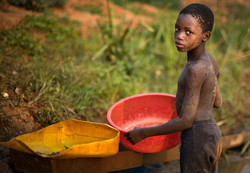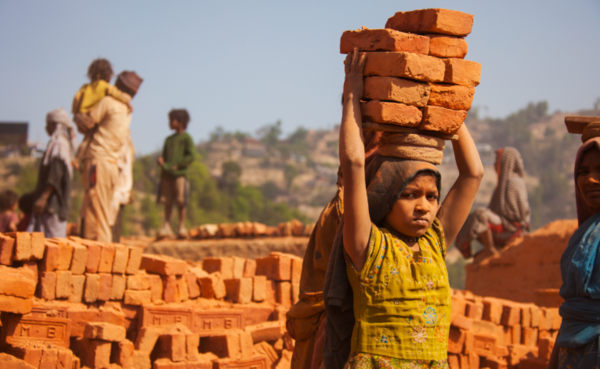
'Labor' means the act of giving a person physical or mental effort to obtain the necessary supplies for life. And 'child labor' means 'the use of children to do work that should be done by adults'. Some of the working children we think are voluntarily working, dreaming of a brighter future than anyone else. However, some children are sold through kidnapping and trafficking. Actually, the fact that the latter cases are more common has emerged as a serious problem in society. Illegal profits earned by brokers from illegal child sales account for up to 35 trillion won per year. More and more children are being physically and mentally abused without proper pay. Let's find out one by one what "modern slavery" is for children, why they have no choice but to work, and what we can to do for them.
21C Dark Shadows That We Cannot Ignore – Child Labor
The complicated reality of child labor
'Child labor' is mainly defined as 'work that interferes with children's education and that is physically, mentally, socially and morally harmful to children.' According to the International Labor Organization (ILO) as of December 2018, more than 152 million children between the ages of 5 to 14 are being exploited for child labor. This is about 13 percent of the world's young children, and the rate is increasing every year. About 59 percent of child laborers, are found to be engaged in agriculture, while about 7 percent are found to be working in factories. In addition, about 22,000 children die a year because of such child labor. Why did these young children jump into the scene of intense labor early on? The biggest reason for child labor worldwide is poverty. If children live in a poor, developing, country, they make work to help support their families. Other reasons for child labor include if they are dragged into illness due to war or if they have nothing to eat due to natural disasters. Such diverse causes are forcing countless children around the world to work.
Are you happy? - Child slaves

‘Child slavery’ refers to the harshest forms of child labor, such as human trafficking, prostitution, and child soldiers. According to the ILO, a child's environment in which children work is divided into child slaves if even one condition of four is met. First, the child's working hours exceed 60 hours a week. Second, the factory uses dangerous machines or objects. Third, working in a dangerous environment, such as selling drugs. The fourth case is sexual abuse, either mentally or physically. It is said that there are about 85 million child slaves around the world, which is about 1.6 times the population of Korea. What are the constantly repeating children's slaves around the world?
Black Future Without an Escape – An Endless System of Slave
Hidden stain on 'The Kingdom of the Gentleman' - the United Kingdom
A common misconception is that child slavery is occurring only in underdeveloped or developing countries. However, the issue of child slavery is also serious in Britain, which we commonly known as an advanced country. According to the British newspaper Telegraph, 475 cases of child slavery were reported in 2019, more than nine times the number in 2017. One example is a hair salon. It is said that the child slaves worked 60 hours a week without pay; and that some broker would provide jobs for children and young people in developing countries. In 2015, there was an incident in which teenagers from Vietnam were forced to work at nail shops. In the wake of the incident, Britain has implemented a 'Modern Slavery Act' since 2015. Britain increased the maximum sentence of related crimes from 14 years to life imprisonment through the Modern Slavery Act. It is also actively responding to modern slavery by finding grounds to support legal restrictions thorough confiscation of the criminal's assets. Child slaves identified in the U.K. belong mainly to criminal groups and have been involved in drug trafficking and prostitution.
Scene of brutal secondary violence – Somalia
It is especially child soldiers that cannot be excluded from child slavery. This problem is especially serious in countries that are engaged in civil war. In the case of Somalia, Africa, the government was criticized for using child soldiers as spies to obtain information on Islamic extremism even if the children captured by Islamic extremist groups were rescued. The Somali government is not providing proper treatment for child soldiers who could have serious trauma such as physical injuries, gunshot wounds, or psychological disorders caused by their trials. Children are being used as objects to identify information from Islamic militia groups. Hundreds of children are being kidnapped and taken away as child soldiers just because they are easier and more efficient than adults.
Exposure of merciless sexual violence – Kingdom of Eswatini
There are various child slaves in the small South African country, the Kingdom of Eswatini (Swaziland). Among them, the most common thing is prostitution. According to UNICEF's survey, in 2019, there are more than 500 cases of child violence every month, of which about 40 percent are teenagers under the age of 19 and 84 percent are female. Every child in the world deserves to be protected. However, that natural proposition has not been observed to this day. What efforts should we make to solve this problem?
What Should We Do to Solve This Problem?

In an effort to prevent increasingly serious child labor, the International Labor Organization (ILO) has designated June 12th every year since 2002 as the "World Day Against Child Labor." Since 2002, the campaign has been under the theme of "The Future Without Child Labor." Every year, the day holds campaigns around the world to eradicate child labor based. People strive to make more children happy by providing psychological treatment, medical services, and economic support through links with schools, various children's organizations, and youth organizations. The aforementioned ILO created a regulation in 1999 that prohibits harsh forms of work (such as unpaid work for more than 60 hours a week, sexual exploitation, child soldier, etc.) for children under 18. In addition, on the occasion of the "World Day Against Child Labor" on June 12th, the International Relief and Development Non-governmental Organization (NGO) is conducting a "child labor abolition project" to help children get away from the actual labor force.
Children are more likely to be exposed to danger than adults. Plus, the risks vary, including, but not limited to, (sexual) violence, disease, and poverty. Children are the main characters who will lead society in the future. As adults, we are obliged to provide them with an opportunity to dream of a happy future. The clothes we're wearing, our shoes, even our food.... Many of these products come to us through child labor. The average age of child labor is 15. Of course, there are many younger children. UNICEF's results confirm that as of 2020, more than 100 million children will be driven to some sort of pain. CAH hopes that constant attention will be provided to create an environment where children who are exploited by labor can live like children should: happy and free to imagine a brighter future.

